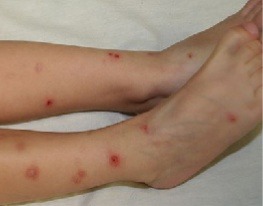About Us


Papular urticaria is an exaggerated allergic response to insect bites seen in sensitive individuals.
Papular urticaria
Papular urticaria is an exaggerated allergic response to insect bites seen in sensitive individuals. It is more common in children than in adults.
Crops of very itchy red bumps, 0.2 – 2 cm in diameter, appear every few days during the summer or autumn months. Sometimes each spot develops a fluid-filled blister up to one centimeter in diameter.
They are most often on the legs and other uncovered areas such as forearms and face (in case of flying insects like mosquitoes) but sometimes they are scattered in small groups over covered areas like the back and buttocks (in case of crawling insects like bed bugs). They can also be a reaction to pet fleas.
If ignored, they can get infected. Sometimes one new spot provokes all the old ones to come up again and itch intensely. Papular urticaria may begin at any age and may last 2-6 years if the insect bites are not avoided. It begins in pre- school children and tends to improve with age.
The growing immune system of children will produce an exaggerated response to insect bites. Often after a few years the person becomes desensitized to these insects and the reaction dies down. A bite isn’t usually noticed and it is thought that the reaction can occur simply from skin contact with parts of the insect such as its faeces and eggs – this accounts for spots in unexpected places.
Not everyone with papular urticaria has pets, and it can be nearly impossible to work out what a patient is reacting to. There have been reports of allergy to bird mites, dust mites, carpet beetles, caterpillars and insects that live in masonry disturbed by renovation.
Protection :
- By keeping the body fully covered during evenings and bedtimes (full-sleeved pajamas).
- Using mosquito repellants in the mornings and evenings.
- Use of mosquito mats 2 times a day.
- In very young children, use gel form of insect repellants in the mornings and evenings.
- Mosquito nets may be used at bed times.
- If there are pets at home, get them examined for fleas by a veterinarian twice in a year.
